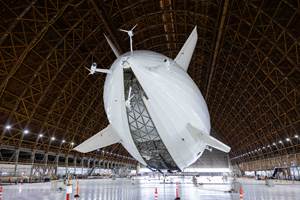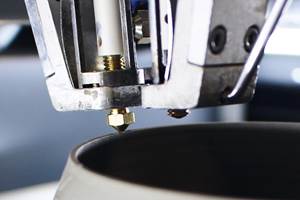GKN to build Boeing 737 MAX winglets in UK and Sumner, WA
Originally slated for its Orangeburg, SC facility, GKN will set up new assembly plant near Tacoma for Advanced Technology winglets.
Boeing's (Chicago, IL, US) selection of GKN Aerospace (Redditch, UK) to manufacture the Advanced Technology Winglet for the 737 MAX was announced in 2013. At that time, GKN said it would build the winglets at its UK composite production center in Cowes on the Isle of Wight with final assembly at its facility in Orangeburg, SC in the US. The latter opened in 2012 with 75 employees and assembles all-composite fuselages for the HondaJet light business jet. It was projected to potentially reach 500 employees by 2017.
As reported last week by Dominic Gates in the Seattle Times, GKN now says it will establish a 5295m2 winglet assembly plant in Sumner near Tacoma, WA in the US, which will employ roughly 75 people at full production. This will reportedly be new work for Washington state. Winglets for the current 737 NG model are made by FACC (Ried im Innkreis, Austria). There is a second source for the 737 MAX Advanced Technology (AT) winglet, Korean Air Aerospace Division (KAL-ASD, Seoul, South Korea).
The governor of Washington, Jay Inslee, and Washington's state Department of Commerce have approved an incentive agreement for GKN which includes more than $600,000 to help recruit and train new employees as the Sumner facility is brought on line. GKN is also eligible for Washington state’s standard set of aerospace tax incentives, which reduce the taxes paid on sales. The value of those tax breaks depends on the new facility's future economic activity.
The head of Governor Inslee's aerospace office Alex Pietsch said that the governor discussed the possibility of opening a new plant in the state with GKN executives at last year's Farnborough Air Show. The Seattle Times quotes Pietsch as noting, “There’s an opportunity for GKN to do even more work here in future."
The AT winglet features a new in-house Boeing design featuring a downward-swept blade in addition to the upward-swept blade now commonly installed on 737s.
Boeing spokeswoman Lauren Penning has said that both GKN and KAL-ASD will send components to GKN’s Sumner plant for assembly into completed winglets, which will then be painted before delivery to the 737 assembly plant in Renton, WA, US. This proximity reportedly allows GKN to respond quickly to any last-minute production needs or changes.
The Advanced Technology winglet differs from the upward-tilted Blended Wingtip developed in association with Aviation Partners, in that it is an all-Boeing design and extends divergently both above and below the wingtip. Boeing describes it as a “dual feather” design using “natural laminar flow technology.” The AT Winglets measure 2.4m from root to top of winglet and 3m from bottom of lower tip to top of higher tip. Boeing claims they will produce a 1.5% fuel burn improvement over current technology winglets.
The 737 MAX is Boeing’s newest family of single-aisle aircraft. Boeing’s AT Winglet is one of a number of design updates that will result in less drag and further optimize the 737 MAX performance, especially on longer-range missions. In total these updates will reportedly deliver an 8% per-seat operating cost advantage over future competition.
Aircraft development is on schedule with firm configuration set in July 2013, first flight scheduled for 2016 and deliveries to customers beginning in 2017. GKN will deliver the first developmental winglet ship sets to Boeing in 2015. The 737 MAX has more than 1,600 orders from airlines around the world. The Seattle Times reports that Boeing plans to produce 26 737 MAX aircraft per month by 2018 and will likely complete the transition from the current 737 model to build 52 MAX aircraft per month within a couple of years.
Related Content
Plant tour: Airbus, Illescas, Spain
Airbus’ Illescas facility, featuring highly automated composites processes for the A350 lower wing cover and one-piece Section 19 fuselage barrels, works toward production ramp-ups and next-generation aircraft.
Read MoreNext-generation airship design enabled by modern composites
LTA Research’s proof-of-concept Pathfinder 1 modernizes a fully rigid airship design with a largely carbon fiber composite frame. R&D has already begun on higher volume, more automated manufacturing for the future.
Read MoreOtto Aviation launches Phantom 3500 business jet with all-composite airframe from Leonardo
Promising 60% less fuel burn and 90% less emissions using SAF, the super-laminar flow design with windowless fuselage will be built using RTM in Florida facility with certification slated for 2030.
Read MoreA new era for ceramic matrix composites
CMC is expanding, with new fiber production in Europe, faster processes and higher temperature materials enabling applications for industry, hypersonics and New Space.
Read MoreRead Next
VIDEO: High-volume processing for fiberglass components
Cannon Ergos, a company specializing in high-ton presses and equipment for composites fabrication and plastics processing, displayed automotive and industrial components at CAMX 2024.
Read MoreAssembling the Multifunctional Fuselage Demonstrator: The final welds
Building the all-thermoplastic composite fuselage demonstrator comes to an end with continuous ultrasonic welding of the RH longitudinal fuselage joint and resistance welding for coupling of the fuselage frames across the upper and lower halves.
Read MoreComposites end markets: New space (2025)
Composite materials — with their unmatched strength-to-weight ratio, durability in extreme environments and design versatility — are at the heart of innovations in satellites, propulsion systems and lunar exploration vehicles, propelling the space economy toward a $1.8 trillion future.
Read More











